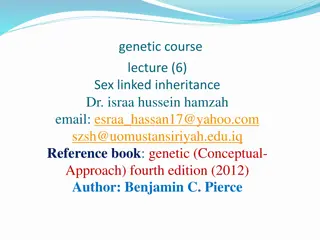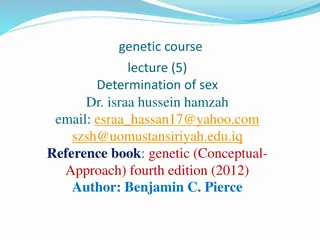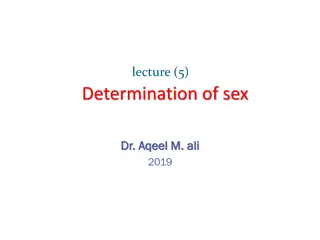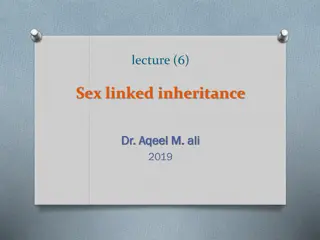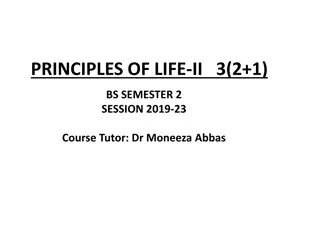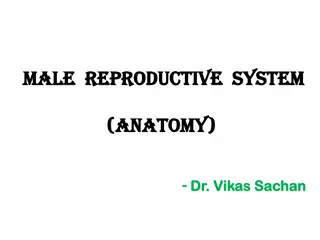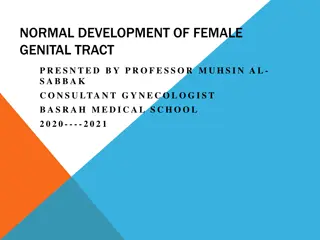Sex Determination Mechanisms in Organisms
The Department of Zoology explores the fascinating world of sex determination systems in organisms, shedding light on the role of chromosomes and genes in sexual characteristics development. From the experiment of Henking to the discoveries of McClung, Stevens, and Wilson, this study delves into the complex mechanisms governing sex determination in dioecious organisms. Discover the intriguing differences between monoecious and dioecious organisms, and unravel the mysteries of sexual dimorphism and germ cell formation.
Download Presentation

Please find below an Image/Link to download the presentation.
The content on the website is provided AS IS for your information and personal use only. It may not be sold, licensed, or shared on other websites without obtaining consent from the author.If you encounter any issues during the download, it is possible that the publisher has removed the file from their server.
You are allowed to download the files provided on this website for personal or commercial use, subject to the condition that they are used lawfully. All files are the property of their respective owners.
The content on the website is provided AS IS for your information and personal use only. It may not be sold, licensed, or shared on other websites without obtaining consent from the author.
E N D
Presentation Transcript
SEX DETERMINATION KOLLA SWATHI BSC CBZ
DEFINITION A sex determination system is a biological system that determines the development of sexual characteristics in an organism.
INTRODUCTION The sexually producing organisms may be classified into two types: Monoecious or Bisexual Dioecious or Unisexual 1. 2. Here the male and female organisms are identified by the primary sex organs they poses such as Testes and ovaries respectively, in addition to the sexual organs difference in size or appearance between sexes is called as sexual dimorphism. The phenomenon of sexual dimorphism has been a riddle for biologists for a long time. Now it is clear that chromosomes and genes play a vital role in the determination of sex.
Sex determination mechanism in dioecious organisms Experiment of Henking H. Henking a German biologist, while studying in the spermatogenesis of the squash bug pyrrhocoris, he noticed that half the spermatozoa possessed an extra chromosome which he called X body But he did not speculate on the significance of this body.
Experiment of Mc Clung He observed that xiphidium fasciatun contained 24 chromosomes whereas the male contained only 23 He suggested that X Body was involved in the sex determination of this insect. But he erroneously considered it to be peculiar to males, because he could not succeed in tracing the Oogenesis of female.
Experiment of Steven and Wilson They both were successfully followed both Oogenesis and Spermatogenesis in some bugs of protenor. In these insects they observed difference in the chromosomal number in both male and female sexes. The female carried 14 and male 13 chromosomes. The female producing eggs with 7 chromosomes each and male producing 2 types of sperms, one with 7 and another with 6 chromosomes only. So, the eggs fertilized by sperms of 7 chromosomes developed into females and those fertilized by sperms of 6 chromosomes developed into males. And also they found another type of sex determination in milk weed bug, Lygaeus turcicus It carries same number of chromosomes in both sexes But the male have heterologous chromosomes ie X and Y.
Types of formation of germ cells There are two systems of formation of germ cells in males and females. Male hetero and female homogametic type: In this system the females are known to produce similar eggs, all with one x chromosome, so the female is known as homogametic sex. In males half the sperms produced carry x chromosomes while the other half carry no x chromosomes, so the male is known as hetero gametic First example: XX-XO type in order hemiptera and orthoptera 1.
Types of formation of germ cells Second example: XX-XY type in man and other mammals.
Importance of Y Chromosome in man In man the Y chromosomes is essential for determining the masculinity as well as male fertility. The conclusive evidence that Y chromosome is a determiner of fertility and sex in male came from certain abnormalities or syndromes. There are two such importance syndromes Turners syndrome or XO type In these persons the chromosomal Number appears as 45, as 1 Chromosome is missing. 1.
2. Klinifelter syndrome It is XXY type. These persons will have 47 Chromosomes instead of normal 46
Types of formation of germ cells 2. Male homogametic and female heterogametic type: in this females are heterogametic and males are homogametic First example: ZO-ZZ type
Types of formation of germ cells Second example: ZW-ZZ type
Other theories of sex determination There are mainly five theories to explain the phenomenon of sex determination Theory of alternate dominants Theory of metabolic difference Quantitative theory Theory of heterozygosity Theory of genic balance 1. 2. 3. 4. 5.
Experiments of bridges Bridges could succeeded in producing a triploid female (AAA+ XXX) because of the phenomenon of Non disjunction
Barrbody A densely staining inactivated condensed x chromosome that is present in each somatic cell of most female mammals and is used as a test of genetic femaleness.
Conclusion So after all these observations we concluded that the sex determination is not in our control, it is based on our chromosomes






